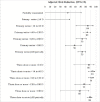Waning vaccine response to severe COVID-19 outcomes during omicron predominance in Thailand
- PMID: 37167215
- PMCID: PMC10174527
- DOI: 10.1371/journal.pone.0284130
Waning vaccine response to severe COVID-19 outcomes during omicron predominance in Thailand
Abstract
Background: The COVID-19 pandemic has evolved quickly, with different variants of concern resulting in the need to offer continued protection through booster vaccinations. The duration of enhanced protection with booster doses against severe COVID-19 is still unclear. Understanding this is critical to recommendations on the frequency of future booster doses.
Methods: Utilising a Hospital Information System for COVID-19 established in Chiang Mai, Thailand, we conducted a cohort study by linking patient-level data of laboratory-confirmed COVID-19 cases to the national immunization records, during the omicron predominant period (1 February- 31 July 2022).
Results: Out of 261,103 adults with COVID-19 included in the study, there were 333 (0.13%) severe COVID-19 cases and 190 (0.07%) deaths. Protection against severe COVID-19 was highest with boosters received >14-60 days prior to positive test (93%) and persisted at >60-120 days (91%) but started to wane at >120-180 days (77%) and further at >180 days (68%). The rate of waning differed with age. Those ≥70 years showed faster waning of booster vaccine responses as compared to those aged 18-49 years, who retained good responses up to 180 days. Equivalent risk reduction against severe COVID-19 was seen with all the vaccine types used as boosters in Thailand.
Conclusions: Booster doses provided high levels of protection against severe COVID-19 with omicron, up to 4 months. Repeat boosters will be required to continue protection beyond 4 months, particularly in the elderly. mRNA and viral vector vaccines can be used flexibly to improve booster coverage.
Copyright: © 2023 Intawong et al. This is an open access article distributed under the terms of the Creative Commons Attribution License, which permits unrestricted use, distribution, and reproduction in any medium, provided the original author and source are credited.
Conflict of interest statement
The authors have declared that no competing interests exist.
Figures


References
-
- Our World in Data. Coronavirus Pandemic (COVID-19). Available online at https://ourworldindata.org/coronavirus. [Last accessed 30 January 2023].
-
- GISAID, nCoV-19 Variants Dashboard. Available online at https://gisaid.org/hcov-19-variants-dashboard/ [Last accessed 1 December 2022].
Publication types
MeSH terms
Substances
LinkOut - more resources
Full Text Sources
Medical

